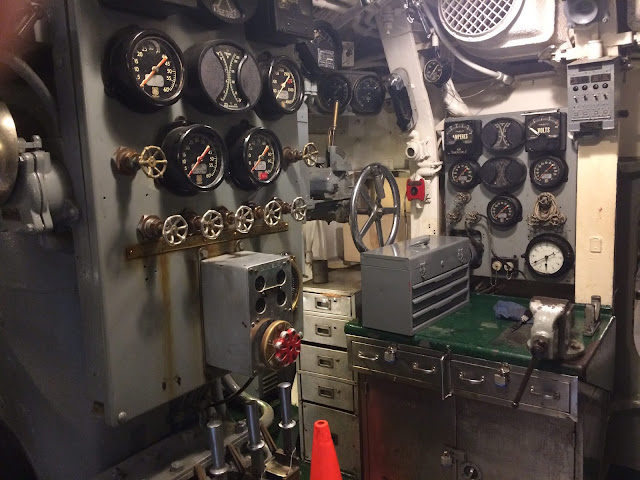I toured the USS Silversides submarine this week with a tour guide that served on Nuclear subs. The sub is from WWII and all original. The complete story of this submarine is located at https://en.wikipedia.org/wiki/USS_Silversides_(SS-236). The Navy submariners are all volunteer to serve on submarines. I don't believe it would be for me!
 |
| The ships sunk and damaged and other awards are painted on the ship. |
 |
| The museum has lots of displays and information about submarines. |
 |
| This is a 4 inch shell that is fired from the deck gun. |
 |
| The aft end of the sub has four torpedo tubes. The 3000 pound torpedos are stored on each side. They are pushed into the tubes by the roller seen on the left side. |
 |
| Torpedo stored on rollers in the rack. |
 |
| The aft engine room with four huge diesel engines. |
 |
| Mechanics bench.They had to do repairs as needed. They needed small men to get in areas behind equipment. |
 |
| Those water tight doors are not good for larger people to pass through. The deck plates are all removable to access more of the engine under the floor. We did not get to see that area. |
 |
| The galley, not very big to feed everyone. They did eat well on subs. |
 |
| Food served here. |
 |
| The radio room. It was locked so I could not get a close look. |
 |
| Lots of brass and copper! Remember, everyone had to know how to operate all of this. |
 |
| They called this side of the control room the "dry side". These controls were used for surfacing operations. |
 |
| Lights indicate all valves and tanks for diving and surfacing. |
 |
| That small table at the bottom of the photo is the chart table. |
 |
| Bunks were right by the torpedos in the racks. |
 |
| The forward torpedo tubes. There are six here, two under the floor. One torpedo for tube 5 is visible in this photo. |
 |
| The underwater escape access, hatch is on the top deck. |
 |
| Torpedo loading done here. Cranes lift them onto this skid. This folds down when not in use. |
 |
| Deck gun shells are stored behind the round watertight doors. The gun on the left is a 20mm gun. |
 |
| The four inch forward deck gun for surface firing. Five men operate the gun, two on seats left and right for rotation and elevation and three to load shells. |
 |
| The 50 cal gun is visible on the conning tower. Our tour guide did a great job of explained all the equipment on the sub. |
 |
| The Hedgehog fired all these mortars from surface ships to destroy submarines. |












069E708261
ReplyDeletesteroid sipariş
ücretli whatsapp şov
steroid fiyatları